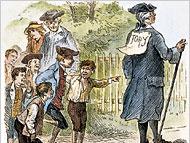From the previous lessons it can seen that not all colonists wanted to go to war. Why were Loyalist opinions not represented as much as the Patriots? A lot of this is due to the treatment of Loyalists by the rebel government and its citizens. The rebels treatment of Loyalists made them fear discovery and oppression. After the American Revolution, around 80,000 Loyalists left the United States for Canada for fear of increased oppression by the now United States government.
To better understand the perspective of Loyalists during the Revolution, students should understand how patriots treated known or suspected loyalists. Students will learn about the Oath of Allegiance of 1777 that effectively made opposition to the revolution very dangerous for Loyalists and their families. Students will read and interpret the accounts of Rebecca Shoemaker and her family. Students will read Samuel Fisher’s story of his arrest by the Philadelphia colonial government for being suspected of being a Tory and how both Fisher and his family were treated by the patriots for their beliefs. Students will also analyze a representation of the most famous traitor of the American Revolution, Benedict Arnold. Using a Venn diagram, students will describe the similarities and differences between the perspectives of Rebecca Shoemaker, Samuel Fisher, and the representation of Benedict Arnold.

